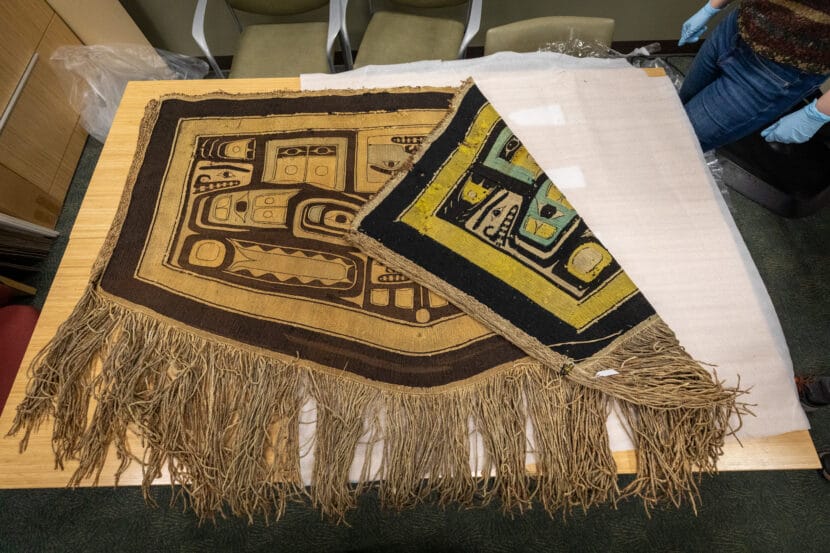
A Chilkat robe that could be hundreds of years old was purchased at auction late last year by a group of donors and given to Sealaska Heritage Institute for Chilkat weavers to study.
Tsimshian basket weaver Mangyepsa Gyipaayg Kandi McGilton said she first found the robe when looking for traditional woven baskets online.
“I just stumbled across the robe in an auction,” McGilton said
McGilton sent a photo of the robe to Haida weaver and historian Kajuulth Evelyn Vanderhoop.
Vanderhoop says the robe at the Seattle auction house has the same pattern as a robe that’s at the Museum of Natural History in New York. Nineteenth century ethnographer George Emmons noted that the latter may have been the first Chilkat robe given to Lingít people by Tsimshian weavers.
The mirrored design features formline faces, in faded blue and yellow, outlined in bold black. The face at the top is upside-down with killer whales facing out.
“It’s an exciting chronological story,” she said. “That whole robe has a wonderful story.”
Tsimshian people wove in the Chilkat style originally. Lingít weavers learned the art form through gifted blankets. They’re called naaxein in Lingít.
And McGilton, who lives in Metlakatla, felt a personal connection to the pattern’s history too.
“That trade between the Lingit and Tsimshian with these Chilkat robes — it’s a really fascinating and pretty miraculous thing that has happened throughout our histories,” she said.
She’s had a chance to study old baskets to learn about patterns and techniques, and knew that this robe could offer that opportunity to Chilkat weavers, too.
“There are secrets in the weavings that are just begging someone to look for them,” McGilton said.
And she said she’s glad that the robe is back in Southeast Alaska, so young people in Metlakatla can visit it.
“I feel like it’s important for kids in my community particularly to know that we have a connection to Chilkat weaving, because we don’t have weavers like that in our community, so I want that to be an inspirational story to them,” she said.
McGilton reached out to Kathryn Bunn-Marcuse at the Burke Museum in Seattle to see if the museum could buy the robe and store it.
Bunn-Marcuse, who’s one of the museum’s curators, said she believes living Indigenous artists should have access to old pieces to learn from.
“The collections are the teachers, right?” she said. “The old belongings, these creations have so much knowledge woven into them.”
And a robe like this one could answer many questions.
“The mountain goat wool, the cedar bark, the dyes — when do you collect them? What time of year? How do you process them? What are the right plant materials? What are the mordants in a dye? There’s an unbelievable richness to the Indigenous scientific knowledge that is throughout these old pieces,” she said.
Bunn-Marcuse said the quick time frame wouldn’t have allowed the museum time to review the potential acquisition, so she organized a group of donors to purchase it.
One of the donors, Bob Moore from Seattle, said it’s worth more than the $39,000 the group paid to make sure it doesn’t end up in private hands.
“I know that a full size robe by a contemporary Chilkat Weaver would be $75 [thousand] or $100,000 or more because it takes at least a year, sometimes two years to weave. So we know how much work goes into it,” he said. “So the price for this robe didn’t seem excessive to us at all.”
The Burke Museum connected the donors to Sealaska Heritage Institute and the robe was sent up to Juneau. Local weaver Lily Hope said the robe returning to its homelands helps with revitalizing the art form as a whole.
“I’m most excited to take my students over to Sealaska Heritage Institute. And look at the backside of this robe,” she said. “That’s where we learn the most from our ancestral pieces.”
And that wasn’t possible before now. This robe had been in private collections for at least 60 years, according to SHI.
“It matters that this robe is coming back with accessibility, because many robes throughout history are held in families and aren’t visible to artists and makers,” Hope said.
Hope says it may not be usable in ceremony though. Museums used to use arsenic or mercury as pesticides to preserve old items, making them hazardous now.
The robe is in Sealaska Heritage Institute’s archives and collections department, and next month, weavers will start learning from it.
This story has been updated to clarify how the Burke Museum organized the donation to Sealaska Heritage Institute.